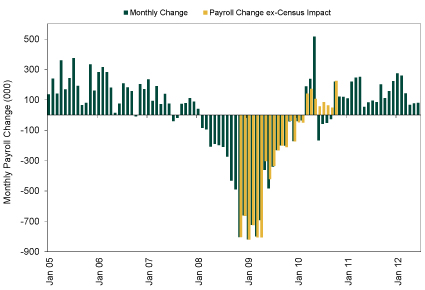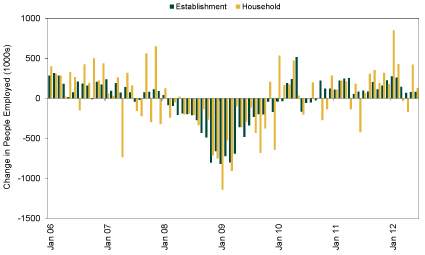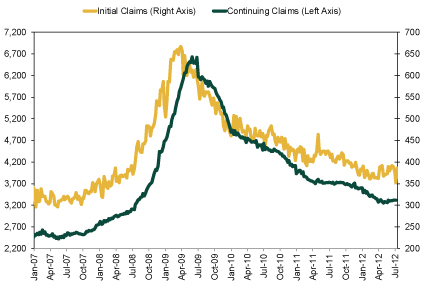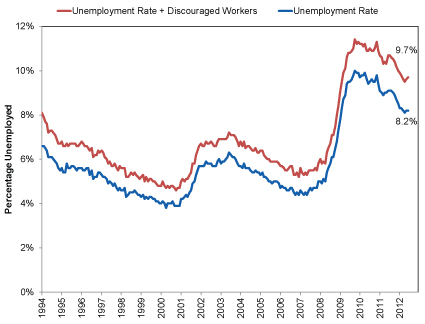Personal Wealth Management / Economics
A Closer Look at US Payrolls and Jobless Claims
Although unemployment improvements seem like they’ve been slow in coming, the broader trend shows ongoing employment growth.
No doubt, unemployment improvements have been slow in coming and volatile at best—most everyone would like to see faster, more consistent gains. But a slow decline in the official unemployment rate isn’t unusual—historically, the rate has fallen slowly as an expansion progresses. What’s more, by focusing solely on the headline number, many may miss the broader trend—which has been improvement and ongoing employment growth.
For example, while it may appear unemployment has only marginally improved since 2009, non-farm payroll reports show the economy has added an average of 126,000 jobs a month for the last 30 months, and employment levels are currently at three-year highs. See Exhibit 1.
Exhibit 1: Non-Farm Payrolls Excluding Census Impact
Sources: Bureau of Labor Statistics, Thomson Reuters.
However, the non-farm payroll headline figure comes from the “Establishment Survey” of large businesses and organizations—which doesn’t directly capture small business hiring. The separate “Household Survey,” used for calculating the unemployment rate, asks people (as opposed to businesses) about their employment status. And the Household Survey shows even higher growth in employment over the past year. (However, see here for our thoughts on the wonkiness of the unemployment rate’s calculation.)
Exhibit 2: Establishment Versus Household Survey Change in Employment (1000s)
Sources: Bureau of Labor Statistics, Thomson Reuters.
Furthermore, initial and continuing jobless claims are significantly lower than at their 2009 peak. Likewise, initial jobless claims remain well below 400,000—a level widely considered a breakeven point for sustainable net job creation in the economy.
Exhibit 3: Initial and Continuing US Jobless Claims
Source: US Department of Labor, Thomson Reuters.
Even when examining broader unemployment trends (including “discouraged workers” who have stopped searching for a new job or are underemployed), the unemployment rate has significantly retreated from its 2009 high. This suggests unemployment rate improvement hasn’t only been because people are dropping out of the work force, but because of natural employment gains—which we believe will persist as the economy continues growing. See Exhibit 4.
Exhibit 4: US Unemployment Rates
Sources: Bureau of Labor Statistics, Thomson Reuters.
To be sure, still-high unemployment clearly isn’t ideal, but as we’ve detailed in the past, larger employment gains often come well into an economic expansion.
If you would like to contact the editors responsible for this article, please message MarketMinder directly.
*The content contained in this article represents only the opinions and viewpoints of the Fisher Investments editorial staff.
Get a weekly roundup of our market insights
Sign up for our weekly e-mail newsletter.

You Imagine Your Future. We Help You Get There.
Are you ready to start your journey to a better financial future?

Where Might the Market Go Next?
Confidently tackle the market’s ups and downs with independent research and analysis that tells you where we think stocks are headed—and why.









